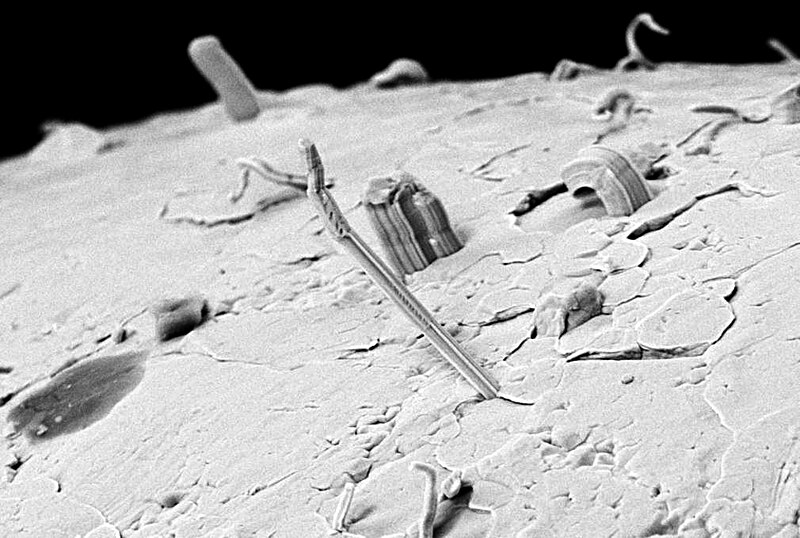File:Tin whisker ESA385984.jpg

原始檔案 (1,010 × 679 像素,檔案大小:264 KB,MIME 類型:image/jpeg)
摘要
| 描述Tin whisker ESA385984.jpg |
English: This may resemble an alien landscape, but it is actually a microscopic view of tin used to solder electronic components. The long shard rising from the surface is a ‘tin whisker’ – a spontaneous outgrowth representing a clear and present danger to space missions.
The phenomenon was first identified within terrestrial electronics, but these whiskers are known to grow rapidly out of pure tin in the weightlessness, vacuum and temperature extremes of space. Typically, these crystalline filaments are just a few thousands of a millimetre thick, though may extend more than a thousand times further in length. They are electrically conductive and so can threaten catastrophic short circuits: the US Galaxy IV telecommunications satellite was lost due to this issue in 1998. The traditional method of preventing tin whiskers was to add lead – but lead is toxic, so its use in solder has been phased out through the EU’s Reduction of Hazardous Substances directive. ESA and European space industry have been granted a waiver to continue using tin–lead alloy for solder, but not an indefinite one. “We’ve been researching alternative methods to arrest the growth of tin whiskers,” explains ESA materials engineer Jussi Hokka. “We’ve investigated a technique called atomic layer deposition, widely used in the semiconductor industry to lay down a metal oxide film just a few nanometres deep. “Over a time period of up to a year, this application has led to a significant reduction in the number of tin whiskers, although we don’t yet know if this is due to the surface barrier laid down or some factor of the overall process.” ESA worked with a consortium led by Finnish specialist Picosun, supported by Finnish packaging specialist Poltronic Ltd and Loughborough University in the UK. Follow-up research is now underway. Success will undoubtedly have wider applications: tin whiskers are also re-emerging as a problem of terrestrial electronics now that pure tin solder is in widespread use. ESA’sTommaso Ghidinicomments: “Tin whiskers remain in many respects a mysterious metallurgical phenomenon. But if this technique proves to be successful, we could safely use pure tin as a green option, foregoing carcinogenic lead – not only for space but also for automotive, aeronautics and large other industrial domains, while guaranteeing equivalent engineering performance.” |
| 日期 | |
| 來源 | http://www.esa.int/spaceinimages/Images/2017/11/Tin_whisker |
| 作者 | European Space Agency |
| 授權許可 (重用此檔案) |
ESA,CC BY-SA 3.0 IGO |
| Title InfoField | Tin whisker |
| Set InfoField | Technology image of the week |
授權條款
This media was created by the European Space Agency (ESA).
Where expressly so stated, images or videos are covered by the Creative Commons Attribution-ShareAlike 3.0 IGO (CC BY-SA 3.0 IGO) licence, ESA being an Intergovernmental Organisation (IGO), as defined by the CC BY-SA 3.0 IGO licence. The user is allowed under the terms and conditions of the CC BY-SA 3.0 IGO license to Reproduce, Distribute and Publicly Perform the ESA images and videos released under CC BY-SA 3.0 IGO licence and the Adaptations thereof, without further explicit permission being necessary, for as long as the user complies with the conditions and restrictions set forth in the CC BY-SA 3.0 IGO licence, these including that:
See the ESA Creative Commons copyright notice for complete information, and this article for additional details.
|
 | |
此檔案採用創用CC 姓名標示-相同方式分享 3.0 國際政府組織授權條款。 姓名標示: ESA, CC BY-SA IGO 3.0
| ||
圖片審查員Wdwd,確認本圖片於2018年4月18日可在下列站點找到並符合所選許可證:
https://www.esa.int/spaceinimages/Images/2017/11/Tin_whisker |
說明
在此檔案描寫的項目
描繪內容
1 11 2017
檔案歷史
點選日期/時間以檢視該時間的檔案版本。
| 日期/時間 | 縮圖 | 尺寸 | 使用者 | 備註 | |
|---|---|---|---|---|---|
| 目前 | 2017年11月1日 (三) 16:55 |  | 1,010 × 679(264 KB) | Fæ | European Space Agency, Id 385984, http://www.esa.int/spaceinimages/Images/2017/11/Tin_whisker, User:Fæ/Project_list/ESA |
檔案用途
下列頁面有用到此檔案:
全域檔案使用狀況
以下其他 wiki 使用了這個檔案:
- cs.wikipedia.org 的使用狀況
- en.wikipedia.org 的使用狀況
- es.wikipedia.org 的使用狀況
- pl.wikipedia.org 的使用狀況
- www.wikidata.org 的使用狀況
詮釋資料
此檔案中包含其他資訊,這些資訊可能是由數位相機或掃描器在建立或數位化過程中所新增的。若檔案自原始狀態已被修改,一些詳細資料可能無法完整反映出已修改的檔案。
| 寬度 | 1,010 px |
|---|---|
| 高度 | 679 px |
| 像素合成 | 黑白(黑為 0) |
| 方位 | 標準 |
| 像素數量 | 4 |
| 水平解析度 | 132 dpi |
| 垂直解析度 | 132 dpi |
| 使用軟體 | Adobe Photoshop CC 2014 (Macintosh) |
| 檔案修改日期時間 | 2017年11月1日 (三) 09:20 |
| Exif 版本 | 2.21 |
| 色彩空間 | 顏色未校準 |
| 原始文件唯一識別碼 | 6F8D04E47D013FC4EBD591A5BEC9DFBA |
| 數位化的日期時間 | 2017年8月22日 (二) 16:21 |
| 詮釋資料最後修改日期 | 2017年11月1日 (三) 10:20 |


